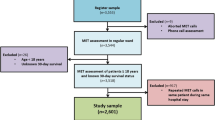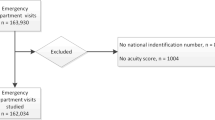Abstract
In emergency rooms, patients are usually classified using scales for predicting risk, resource usage, and the maximum time for receiving medical care. Emergency Severity Index (ESI) is a frequently used scale in this context. However, every patient with cancer is automatically classified as ESI level 3. In this study, patients with cancer seen at an emergency setting were reclassified using the ESI without the “cancer” parameter to verify whether there would be any change in the classification. Cross-sectional study. A convenience sample of all cancer patients who sought immediate care at a private center in Brazil during a 6-month period was included in the study. After receiving care according to the institution’s standards, they were reclassified using the ESI scale without the “cancer” parameter. Times to receiving care and to reaching a diagnosis were recorded. In the study period, 360 patients were reclassified. They sought treatment for infection, pain, and gastrointestinal problems related to chemotherapy. The reclassification led to significant changes in the ESI risk level: 8.8% of the patients initially classified as level 4 had their level changed, as did 10.6% of those at level 3. The number of patients reclassified as level 1 was 3.2% higher than that of the initial classification (p < 0.001). There is a need to create a new scale for the classification of risk that takes the characteristics of patients receiving cancer treatment into account. Specific populations require specific classification scales for better evaluation of risk.
Similar content being viewed by others

References
Prenen K, Prenen H. Oncological emergencies associated with gastrointestinal tumors. Ann Gastroenterol. 2015;28(4):426–30.
McHugh M, Dyke KV, McClelland M, Moss D. Improving patient flow and reducing emergency department crowding: a guide for hospitals. Rockville: Agency for Healthcare Research and Quality; 2011. https://www.ahrq.gov/sites/default/files/publications/files/ptflowguide.pdf. Accessed 13 Mar 2017.
Mirhaghi A, Heydari A, Mazlom R, Hasanzadeh F. Reliability of the emergency severity index: meta-analysis. Sultan Qaboos Univ Med J. 2015;15(1):e71–7.
Gilboy N, Tanabe P, Travers D, Rosenau AM. Emergency severity index (ESI): a TriageTool for emergency department care. Rockville: Agency for Healthcare Research and Quality. AHRQ Publications; 2012. https://www.ahrq.gov/sites/default/files/wysiwyg/professionals/systems/hospital/esi/esihandbk.pdf. Accessed 13 Mar 2017.
Agency for Healthcare Research and Quality (AHRQ). Emergency severity index (ESI): a Triage Tool for emergency department. https://www.ahrq.gov/professionals/systems/hospital/esi/esi1.html. Accessed 13 Mar 2017.
Brasil. Agência Nacional de Saúde Suplementar. Ministério da Saúde. Tempo de espera na Urgência e Emergência. Ministério da Saúde; 2012. http://www.ans.gov.br/images/stories/prestadores/E-ACE-02.pdf. Accessed 13 Mar 2017.
Hing E, Bhuiya F. Wait time for treatment in hospital emergency departments: 2009. NCHS. 2012;102:1–8. www.cdc.gov/nchs/data/databriefs/db102.pdf. Accessed 13 Mar 2017.
Neto PRO. Avaliação do tempo de espera para ver o médico no mês de implantação do Sistema de Triagem Quinta D’Or (STQD)—parte 1. II Congresso Brasileira de Medicina de Emergência. Fortaleza: Associação Brasileira de Medicina de Emergência; 2008.
Tomberg JO, Cantarelli KJ, Guanilo MEE, Pai DD. Acolhimento com avaliação e classificação de risco no pronto socorro: caracterização dos atendimentos [Host with evaluation and risk rating in the emergency: characterization of attendances]. Cienc Cuid Saude. 2013;12(1):80–7.
van der Linden MC, Meester BE, van der Linden N. Emergency department crowding affects triage processes. Int Emerg Nurs 2016; S1755-599X(16)30005-2.
Chaou CH, Chiu TF, Yen AM, Ng CJ, Chen HH. Analyzing factors affecting emergency department length of stay-using a competing risk-accelerated failure time model. Medicine (Baltimore). 2016;95(14):e3263.
Amina S, Barrati A, Sadeghifar J, Sharifi M, Toulideh Z, Gorji HA, et al. Measuring and analyzing waiting time indicators of patients’ admitted in emergency department: a case study. Glob J Heath Sci. 2016;8(1):143–9.
Vandyk AD, Harrison MB, Macartney G, Ross-White A, Stacey D. Emergency department visits for symptoms experienced by oncology patients: a systematic review. Support Care Cancer. 2012;20(8):1589–99.
Drumheller BC, Agarwal A, Mikkelsen ME, Sante SC, Weber AL, Goyal M, et al. Risk factors for mortality despite early protocolized resuscitation for severe sepsis and septic shock in the emergency department. J Crit Care. 2016;31(1):13–20.
Greene J. Concern for cancer: new national institutes of health network to focus on cancer patients in the emergency department. Ann Emerg Med. 2015;66(1):13A–5A.
Author information
Authors and Affiliations
Corresponding author
Ethics declarations
Conflict of interest
All authors declare that they have no conflict of interest.
Rights and permissions
About this article
Cite this article
Manfredini, L.L., dos Santos, G.P., Centrone, A.F.Y. et al. Reclassification of risk in an emergency referral center: the need for a specific tool for the classification of onco-hematological patients. A cross-sectional study. Med Oncol 35, 86 (2018). https://doi.org/10.1007/s12032-018-1136-1
Received:
Accepted:
Published:
DOI: https://doi.org/10.1007/s12032-018-1136-1



